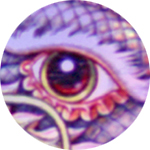No problems.
4. Fan Zhu Quan - Unsure, do you mean fan zhou quan (翻肘拳)?
Here the middle character is a little different. It's actually a very simple character, almost like number seven -> 7 -> but with a stroke through the middle, the way we write number seven here.
Then this should be "Fan Zi Quan" 翻子拳, it was already in the list.
70. Di Shu Quan - 地术拳 ( dog is called "di long" traditionally, so it can be also 地龙拳 ) - The middle character is a little different, but that's maybe because Gene (or whoever wrote this great article) used traditional Chinese. It actually has two options for the middle character of which the one in parentheses is the one I have seen used for dog. Actually, in Potku, we use that one for dog: http://www.potku.net/forum/templates/sky/images/dog.gif
Is the middle character 龍? Thats the traditional character for 龙, another valid name for this style is Di Quan Quan (地犬拳)
75. Da Xia Jia Quan - 大侠家拳 - This is a funny one, four words but only three characters (in the article, that is)?
"This Southern style was founded by Li Hu Zi who studied at Emeishan in Sichuan. He went to Guangdong and passed it to a monk named Huang Yin Ling. Monk Huang left the monastery and returned to secular life and opened a school to teach publicly. This system begins with 'xiaolohan' (small Lohan). Intermediate students study tiger and crane, then advanced students go on to 'dalohan' (big Lohan). It is popular in Guangzhou, Nantai, Hong Kong and Macao."
Upon further research, this style is offically called "Xia jia quan" (侠家拳)
77. Long Zun Quan - 龙尊拳
"Long Zun means 'respect'. The movements of Long Zun Quan are quick, and adaptable, emphasizing defensive techniques. Less jumping and kicking leads to a stronger foundation of stances. Foot techniques also tend to be more conservative. The few attacks tend to be from the side, as a crab moves. Students of Long Zhun Quan pau close attention to facial expressions."
龙(龍)尊拳 is an existing southern shaolin style. May be it is what you are looking for? There really is no other valid names for "long zhun".



 Reply With Quote
Reply With Quote



